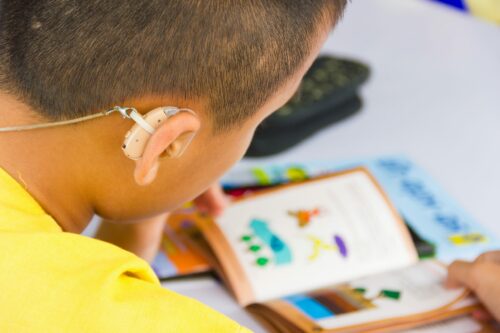By Emily Wright (PhD Student – School of Psychology and Clinical Language Sciences)
There are more than 7000 deaf children in the UK with spoken language bilingualism. These children speak English and another spoken language at home, with or without British Sign Language (BSL) as well (CRIDE, 2019). In the UK, when bilingual parents find out that their child is deaf, they must decide whether to communicate with them using their home language, English and/or BSL. The decision-making process is often challenging as the majority of deaf children are born to hearing parents with little or no knowledge or experience of deafness. Professional advice can therefore greatly influence the decisions they make.
In this study (Wright, Stojanovik, & Serratrice, 2022), 108 professionals completed an online survey to help us investigate their beliefs on spoken language bilingualism in deaf children and what advice they give to bilingual parents. We focussed on three types of practitioners that parents are likely to meet soon after their child is diagnosed as being deaf:
1. Teachers of the Deaf (ToDs)
2. Audiologists
3. Speech and Language Therapists (SLTs)
There are different types and degrees of deafness. In our study, we chose to focus on deaf children with a severe-to-profound sensorineural deafness who use cochlear implants. A sensorineural deafness is a permanent type of deafness that occurs when there is damage to the cochlear and/or auditory nerve. There are four degrees of deafness: mild, moderate, severe and profound. Cochlear implants are a type of implanted hearing device that converts sound into electrical signals, providing a sensation of hearing. They are usually offered to children with a severe-to-profound deafness who don’t benefit from hearing aids.
What were the key findings?
- Can deaf children achieve spoken language bilingualism?
Almost all professionals who participated in the study believed that deaf children with bilateral severe-to-profound sensorineural deafness and cochlear implants can achieve spoken language bilingualism. However, only half to two thirds of the participants believed that deaf children who have additional speech and/or language impairments can learn two spoken languages.
- Factors affecting spoken language bilingualism
All or almost all participants agreed that the following factors affect the likelihood of spoken language bilingualism: amount of exposure to the two languages; age of diagnosis, age of receiving hearing technology, presence of additional speech, language and/or communication impairments, or developmental disorders, and opportunities to speak the two languages.
- Potential outcomes of spoken language bilingualism
Nearly all participants agreed that raising a deaf child to learn their home language leads to: maintenance of the home language; improved family relationships; access to their home culture and a better identity/sense of self. However, 70% of audiologists compared to only just over 25% of ToDs and less than 20% of SLTs said that learning two spoken languages can lead to linguistic confusion in deaf children.
- Professionals’ role in parents’ decision-making
Almost all participants agreed that professionals should advise parents to speak their home language, both those who speak English proficiently and those who do not. More than three quarters of SLTs said they are asked for advice by parents on whether they should raise their deaf child with two spoken languages compared to just under two thirds of ToDs, and just over one third of audiologists. Similarly, a greater percentage of SLTs agreed that both parents’ decisions on language choice are influenced by professional advice (70% SLTs, 40% ToDs, 36% audiologists) and that advising parents on language choices is part of their professional role (81% SLTs, 56% ToDs, 36% audiologists).
This is the first UK based research study on professionals’ beliefs and advice on spoken language bilingualism in deaf children. Professionals, in particular SLTs and ToDs, play a key role in parental decision-making around spoken language bilingualism. To ensure professionals give parents evidenced-based advice, we recommend the following:
- Provide specific training on spoken language bilingualism in deaf children
- Encourage interprofessional collaboration to share specialist knowledge on language development and multilingualism
- Further research on language outcomes in deaf children with spoken language bilingualism
- Review of relevant university training courses to ensure that they include a focus on multilingual populations and multicultural issues
You can read the full open access article here.
What next?
Understanding the parents’ decision-making process would not be complete without including the parents’ voice. We have just completed a second study with parents who chose to raise their deaf child with two or more spoken languages to explore what factors influenced their decision.
Emily Wright is a PhD student in the School of Clinical Language Sciences, investigating spoken language multilingualism in deaf children. Her PhD is being supervised by Prof. Ludovica Serratrice and Prof. Vesna Stojanovik, and is funded bv an ESRC SeNSS 1+3 PhD studentship.


